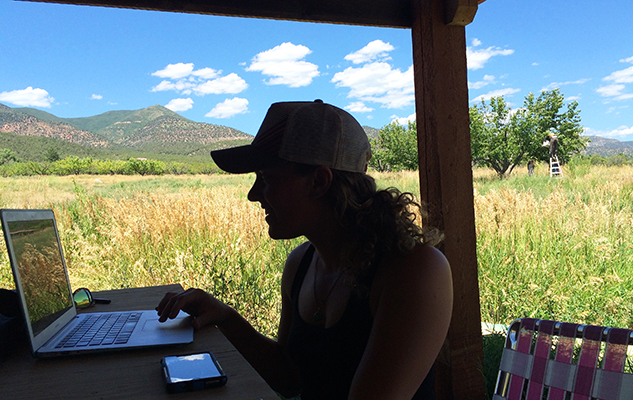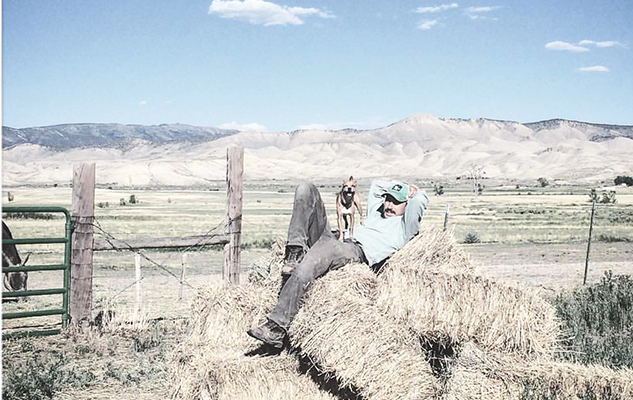
By Stacia Cannon, Topp Fruit
The juvenile plums were a pale, unappetizing green. Then, almost overnight, the trees were adorned with rich purple, speckled fruit. Naked and new, the plums continue to swell and gain even darker, more brilliant hues. In the orchard and elsewhere it has been a very fruitful year, replete with many successes, but also persistent, grinding challenges.
Balancing an off-farm job with the often unpredictable needs of the orchard is a constant battle. When I’m not ranching I work for a vet, and Harrison works full time for the Rocky Mountain Farmers Union. Harrison has the freedom to work remotely, so most days he drives to his “office” at the orchard, a small makeshift desk and a folding chair on the east side of the barn. With internet access and cell phone reception, Harry has everything he needs, plus a killer view of the orchard overlooking Paonia. Still, our home on the ranch is an hour-and-half away—an already long day is made much more taxing when you add a three hour commute on top of it.

Since the orchard is so far from our home, my ability to help out with maintenance is limited to my days off from working at the vet hospital and the ranch, which makes it really hard for us to get some of the less-essential but still-important jobs completed, such as mowing. When we have a million other things that need to get done at the orchard, mowing doesn’t always make the cut. It isn’t essential and we like the wild and beautiful look of the grasses, but when harvest time comes, the foliage is impossible to navigate with a ten-foot ladder and harvest basket. Living closer to the orchard might enable us to get some of these tasks completed, so we’ve started looking for more land that can be our home place and also help us expand our farming ventures. We’re starting the process with a mixture of caution and rollicking enthusiasm bordering on mania.
We made a simple list of things we would like in a property, including acreage, water rights, farming potential, and location. The beginning stages of property hunting are fun and exciting, filled with hope and possibility. The deeper we get into the process, however, the more we become acquainted with fear and vulnerability. There have been more entry barriers than I was prepared for.

There’s a lot of competition for land in our area, from retiree’s, second home owners, investors, and water seekers. Competition from these other buyers has pushed some of the best farmland into a non-agricultural price-bracket. We try not to let the cost of land discourage us. We know the right property for the right price might be a unicorn at this point, and we’ll need to make some compromises and broadened our search—less acreage, more marginal land, less-than-ideal locations. But no matter what, we’re staying firm on good water rights.
If high prices mean that we have to buy fewer acres or less productive land, that puts added pressure on our return-per-acre. We will need to be more efficient, working at a scale that is both affordable and profitable. The thought of investing in agriculture can be sickening. The risk is significant, the rewards unclear. Increasing land values, limited water availability, and declining agricultural markets echo a foreboding warning. I studied agriculture in college so I could be a “smart farmer” and learn the business side of the agricultural industry. I learned a lot while in college, but now I’m struck by the thought that accruing debt to go to college for agriculture is absurd if once you graduate you need to invest in a new farm. This is an industry with very tight margins and heartbreaking repercussions for failure.
I’m not dissuaded from farming, but it’s a long row to hoe. At this stage, having off-farm income is essential, and it may always be. It’s a life of long hours, frugality, and problem solving. But the grass is green and the fruit is sweet. It’s a farmer’s life for me.
***
This post is part of a series following four young farmers/ranchers from Colorado and New Mexico as they write about their experiences with water access and explain everything from what it feels like to clean a 400-year-old acequia to how they’ve learned to make the most of the water they have through conservation and crop selection. To help you understand the terminology around water access, we’ve put together a short glossary at the bottom of this blog post.